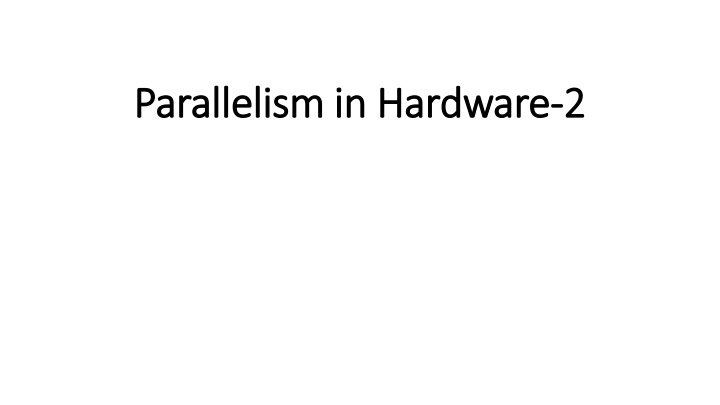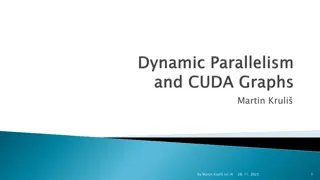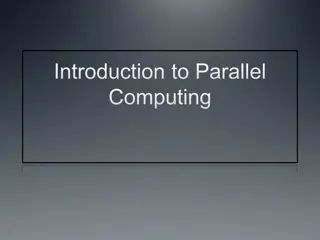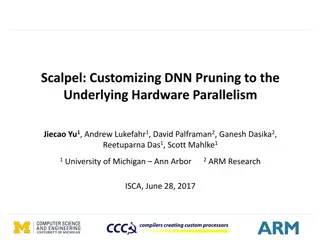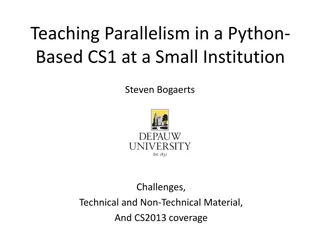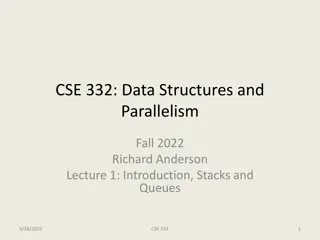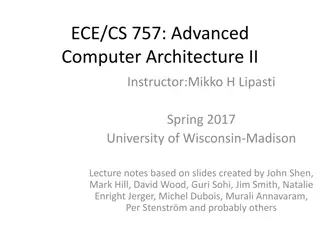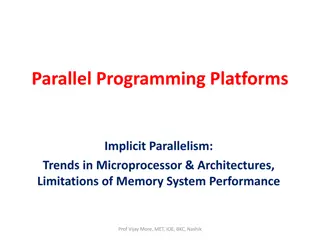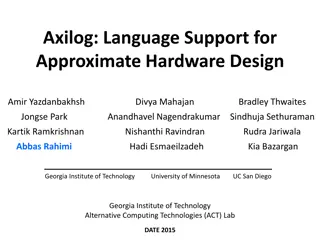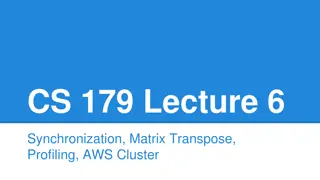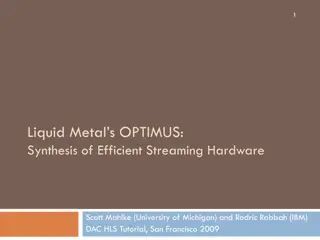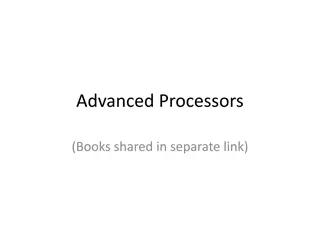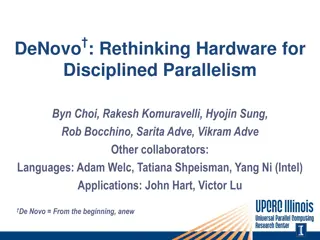Parallelism in Hardware Overview
This content delves into different forms of parallelism in hardware, such as instruction-level parallelism, fine-grained vs. coarse-grained parallelism, SIMD machines, vector processors, shared memory systems, and uniform memory access systems. Explore the concepts and visual representations provided to enhance your understanding of parallelism in hardware.
Download Presentation

Please find below an Image/Link to download the presentation.
The content on the website is provided AS IS for your information and personal use only. It may not be sold, licensed, or shared on other websites without obtaining consent from the author.If you encounter any issues during the download, it is possible that the publisher has removed the file from their server.
You are allowed to download the files provided on this website for personal or commercial use, subject to the condition that they are used lawfully. All files are the property of their respective owners.
The content on the website is provided AS IS for your information and personal use only. It may not be sold, licensed, or shared on other websites without obtaining consent from the author.
E N D
Presentation Transcript
Parallelism Parallelism in Hardware in Hardware- -2 2
Recap Recap Cache memory Virtual memory
Instruction Instruction- -level parallelism level parallelism multiple functional units executing instructions simultaneously. Pipelining arranges functional units are arranged in stages Multiple issue initiatesmultiple instructions a the same time Pipelining: Fetch of X[1] and Y[1] and computation of x[0] +y[0] may happen in parallel by different pipeline units. float x[1000], y[1000], z[1000]; . . . for (i = 0; i < 1000; i++) z[i] = x[i] + y[i]; Multiple issue:Fetch of x[0], , x[n] and y[0] y[n] can be parallel
Fine Grained vs Coarse Grained Parallelism Fine Grained vs Coarse Grained Parallelism ILP is a fine grained parallelism Dependencies limit the scope of ILP. t = a+b; r = X[t]; f[0] = f[1] = 1; for (i = 2; i <= n; i++) f[i] = f[i-1] + f[i-2]; Coarse grain parallelism. - execute larger/coarser unit of computation in parallel. - Multithreading computation
Parallel Hardware Parallel Hardware SIMD machine. Single Instruction Multiple Data Single control unit and multiple ALU. for (i = 0; i < n; i++) x[i] = x[i]+y[i];
Vector processors Vector processors Vector registers Vectorized and pipelined functional units. Vector instructions multiple banks of memory Strided memory access: memory access separated by fixed intervals Many x86 processor support vector computation Compilers generate vector instructions vr1 = b[0:3]; vr2 = c[0:3]; a[0:3] = vr1 + vr2; for (i = 0; i <3; i++) a[i] = b[i] + c[i];
Shared Memory System Shared Memory System Processors communicate implicitly by accessing shared data residing on shared memory.
Uniform Memory Access System Uniform Memory Access System - processors are connected to main memory by interconnects - Shared memory access time is same for all processor
Uniform vs Non Uniform vs Non- -Uniform Memory Access Uniform Memory Access - each processor can have it s block of main memory - processors access each others memory through special hardware - access to other processors memories may take longer
Distributed Memory System Distributed Memory System each processor has its own private memory the processor-memory pairs communicate over an interconnection network Communicate by sending messages
Latency and Bandwidth Latency and Bandwidth Latency is the time that elapses between the source s beginning to transmit the data and the destination s starting to receive the first byte. Bandwidth is the rate at which the destination receives data after it has started to receive the first byte. Let l seconds be the latency of an interconnect and b bytes per second be the bandwidth Time taken to transmit a message of n bytes is l + (n/b)
Cache Coherence Cache Coherence What are the possible values of y1 and z1? y1 = 3*2 z1 = 4*2 = 8 or z1 = 4*7 = 28 y1 = 7*3 z1 = 7*3 = 21 and z1 = 4*2 = 8 is not possible
Cache Coherence Cache Coherence x=2 What are the possible values of y1 and z1? y1 = 3*2 z1 = 4*2 = 8 or z1 = 4*7 = 28 y1 = 7*3 z1 = 7*3 = 21 and z1 = 4*2 = 8 is not possible
Cache Coherence Problem Cache Coherence Problem X=1; X=2; r=X; shared main memory
Snooping Based Cache Coherence Protocol Snooping Based Cache Coherence Protocol When the cores share a bus, any signal transmitted on the bus can be observed by all the cores connected to the bus core 0 updates the copy of x stored in its cache, Core 0 broadcasts this information(cache line that contains x is updated) across the bus core 1 is snooping the bus, Sees that x (or the cache line that contains x) has been updated It can mark its copy of x as invalid. snooping works with both write-through and write-back caches
Drawback of Snooping Drawback of Snooping Based Based Protocol Protocol Broadcasts are expensive Snooping protocol broadcasts every time a variable is updated Not scalable, in larger systems due to performance
Directory Directory- -based cache based cache coherence Protocol coherence Protocol The distributed directory stores the status of each cache line. Each core/memory pair stores the status of the cache lines in its local memory. A read operation updates the directory entry corresponding to that line with the information about the core When a variable is updated, the directory is consulted, and the cache controllers of the cores that have that variable s cache line in their caches are invalidated. Pros. only the cores storing that variable need to be contacted. X=Y; || Y=Z; || Z=X; // T1{X,Y}, T2{Y,Z}, T3{Z,X} Cons. Substantial additional storage required for the directory
False Sharing False Sharing CPU caches operate on cache lines, not individual variables Update on one variable mark the cache line as dirty, other cores fetch the data from the main memory int i, j, iter_count; /* Shared variables initialized by one core */ int m, n, core_count; double y[m]; iter_count = m/core_count; int i, j, m, n; double y[m]; /* Assign y = 0 */ . . . for (i = 0; i < m; i++) for (j = 0; j < n; j++) y[i] += f(i,j); /* Core 0 */ for (i = 0; i < iter_count; i++) for (j = 0; j < n; j++) y[i] += f(i,j); /* Core 1 */ for (i = iter_count+1; i < 2*iter_count; i++) for (j = 0; j < n; j++) y[i] += f(i,j); core_count=2 m=8 doubles are 8 bytes cache line 64 bytes
References References Chapter 2 An Introduction to Parallel Programming by Peter Pacheco.
